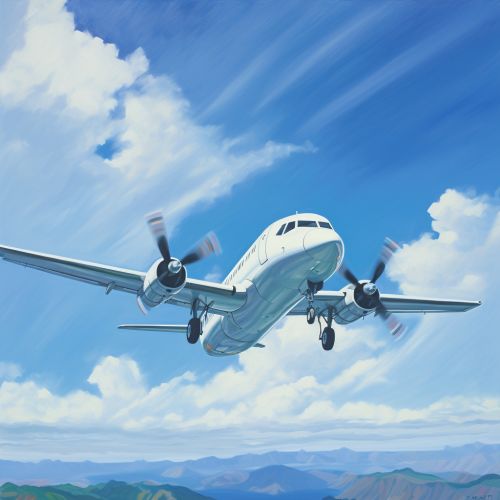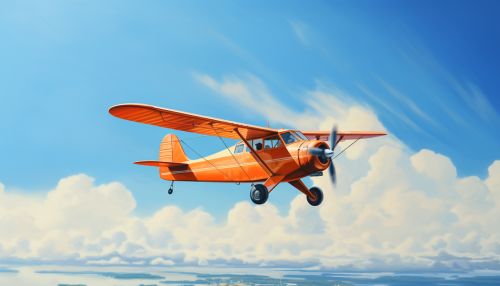Aircraft
History
The history of aircraft can be traced back to the late 18th century with the advent of lighter-than-air flight. The first successful manned flight was achieved by the Montgolfier brothers in 1783, using a hot air balloon. However, the development of heavier-than-air flight, which is the basis for modern aircraft, did not occur until the late 19th and early 20th centuries.


The concept of heavier-than-air flight was first realized by Sir George Cayley in the early 19th century. Cayley is often credited as the father of aeronautical engineering due to his pioneering studies in aerodynamics, including the principles of lift, drag, and thrust. His work laid the foundation for the development of fixed-wing aircraft.
The first successful powered, controlled, and sustained heavier-than-air flight was achieved by the Wright brothers in 1903. Their aircraft, the Wright Flyer, utilized a three-axis control system, which is still used in modern aircraft. This marked the beginning of the era of aviation.
Design and Structure
The design and structure of an aircraft are crucial to its function and performance. An aircraft is typically composed of several key components: the fuselage, wings, empennage, landing gear, and powerplant.
The fuselage is the main body of the aircraft, housing the cockpit, passengers, and cargo. The wings provide lift, a crucial force for flight. The shape and size of the wings can greatly affect the aircraft's performance characteristics, such as speed, maneuverability, and fuel efficiency.
The empennage, or tail, includes the vertical and horizontal stabilizers, which provide stability and control. The landing gear supports the aircraft when it is not in flight, and allows for takeoff and landing. The powerplant, which includes the engine and propeller, provides the necessary thrust for flight.
Propulsion Systems
The propulsion system of an aircraft is responsible for generating thrust. There are several types of propulsion systems, including piston engines, turboprop engines, jet engines, and rocket engines.
Piston engines, also known as reciprocating engines, are commonly used in small, general aviation aircraft. They operate on the principle of internal combustion, where fuel is burned in a combustion chamber to produce high-pressure gas that drives a piston.
Turboprop engines are a type of gas turbine engine, where a turbine is used to drive a propeller. They are more efficient than piston engines at higher speeds and altitudes, and are commonly used in regional airliners and military aircraft.
Jet engines operate on the principle of jet propulsion, where air is taken in at the front of the engine, compressed, mixed with fuel and ignited, and then expelled as a high-speed jet of gas at the rear. They are used in most commercial airliners and military fighter jets.
Rocket engines are used in spacecraft and some experimental aircraft. They operate on the principle of rocket propulsion, where fuel and an oxidizer are combined and ignited to produce a high-speed jet of gas.
Aerodynamics
Aerodynamics is the study of how air moves around objects, and is a fundamental aspect of aircraft design. The four forces of flight – lift, weight, thrust, and drag – are all influenced by aerodynamics.
Lift is the force that opposes weight and allows an aircraft to rise into the air. It is generated by the flow of air over the wings, which are designed with a special shape – called an airfoil – that causes air to move faster over the top surface than the bottom, resulting in lower pressure on the top and higher pressure on the bottom.
Weight is the force of gravity acting on the aircraft, pulling it down towards the earth. Thrust is the force that propels the aircraft forward, and is generated by the aircraft's propulsion system. Drag is the force that opposes thrust and slows the aircraft down. It is caused by the resistance of the air moving over the aircraft's surface.
By understanding and manipulating these forces, aircraft can be designed to fly faster, higher, and more efficiently.
Aircraft Types
There are many different types of aircraft, each designed for specific purposes. These include fixed-wing aircraft, rotary-wing aircraft, lighter-than-air aircraft, and spacecraft.
Fixed-wing aircraft, such as airplanes and gliders, have wings that are fixed in place and generate lift by moving forward through the air. They are the most common type of aircraft.
Rotary-wing aircraft, such as helicopters and autogyros, have rotating wings or blades that generate lift by spinning around a central mast. This allows them to hover, take off and land vertically, and move in any direction.
Lighter-than-air aircraft, such as balloons and airships, generate lift by filling a large envelope with a gas that is lighter than air, such as helium or hot air.
Spacecraft, such as rockets and space shuttles, are designed to operate outside of the earth's atmosphere.
Aircraft Operations
Aircraft operations encompass a wide range of activities, including flight planning, navigation, communication, and emergency procedures.
Flight planning involves determining the route of a flight, taking into account factors such as weather conditions, fuel requirements, and airspace restrictions. Navigation involves guiding the aircraft along the planned route, using instruments and navigation aids.
Communication is crucial for maintaining safety in the airspace, and involves interacting with air traffic control and other aircraft. Emergency procedures are in place to handle situations such as engine failure, loss of control, and medical emergencies.
